OBJECTIVES
The student are going to be ready to
• perceive the applications of the magnetism waves in free area.
• introduce the operating principles of assorted forms of antennas
• discuss the key applications of antennas with a stress on however antennas ar utilized to satisfy
electronic system necessities.
• perceive the ideas of radio emission propagation within the atmosphere.
UNIT I
ANTENNA FUNDAMENTALS: Introduction, Radiation Mechanism – single wire, 2 wire, dipoles, Current Distribution on a skinny wire antenna. Antenna Parameters – Radiation Patterns, Patterns in Principal Planes, Main Lobe and aspect Lobes, Beamwidths, Polarization, Beam Area, Radiation Intensity, Beam potency, directionality, Gain and backbone, Antenna Apertures, Aperture potency, Effective Height, illustrated issues.
UNIT II
skinny LINEAR WIRE ANTENNAS: half-witted Potentials, Radiation from little dipole, Quarter wave Monopole and 0.5 wave Dipole – Current Distributions, analysis of Field elements, Power Radiated, Radiation Resistance, Beamwidths, directionality, Effective space and Effective Height. Natural current distributions, fields and patterns of skinny Linear Center-fed Antennas of various lengths, Radiation Resistance at a degree that isn’t current most. Antenna Theorems – relevancy and Proofs for equivalence of directional characteristics, Loop Antennas: little Loops – Field elements, Comparison of way fields of little loop and short dipole, construct of short dipole, D and Rr relations for tiny loops.
UNIT III
ANTENNA ARRAYS : a pair of part arrays – totally different cases, Principle of Pattern Multiplication, N part Uniform Linear Arrays – Broadside, End-fire Arrays, EFA with exaggerated directionality, Derivation of their characteristics and comparison; construct of Scanning Arrays. directionality Relations (no derivations). connected issues. Binomial Arrays, Effects of Uniform and Non-uniform Amplitude Distributions, style Relations. Arrays with Parasitic parts, Yagi-Uda Arrays, accordion Dipoles and their characteristics.
UNIT IV
NON-RESONANT RADIATORS : Introduction, wave radiators – basic ideas, Long wire antennas – field intensity calculations and patterns, Microstrip Antennas-Introduction, Features, blessings and Limitations, Rectangular Patch Antennas –Geometry and Parameters, Impact of various parameters on characteristics. Broadband Antennas: voluted Antennas – Significance, Geometry, basic properties; style issues for monofilar voluted antennas in Axial Mode and traditional Modes (Qualitative Treatment).
III Year – I Semester
L T P C
4 0 0 3
ANTENNA AND WAVE PROPAGATION
UNIT V
VHF, UHF AND MICROWAVE ANTENNAS : Reflector Antennas : Flat Sheet and Corner Reflectors. rounded Reflectors – pure mathematics, characteristics, forms of feeds, F/D Ratio, Spill Over, Back Lobes, Aperture block, Off-set Feeds, Cassegrain Feeds. Horn Antennas – sorts, Optimum Horns, style Characteristics of pyramidical Horns; Lens Antennas – pure mathematics, Features, insulator Lenses and sectionalisation, Applications, Antenna Measurements – Patterns needed, Set Up, Distance Criterion, directionality and Gain Measurements (Comparison, Absolute and 3-Antenna Methods).
UNIT VI
WAVE PROPAGATION : ideas of Propagation – frequency ranges and kinds of propagations. radio wave Propagation–Characteristics, Parameters, Wave Tilt, Flat and Spherical Earth issues. radio radiation Propagation – Formation of Ionospheric Layers and their Characteristics, Mechanism of Reflection and Refraction, important Frequency, MUF and length – Calculations for flat and spherical earth cases, Optimum Frequency, LUHF, Virtual Height, Ionospheric Abnormalities, Ionospheric Absorption. elementary Equation for Free-Space Propagation, Basic Transmission Loss Calculations. area Wave Propagation – Mechanism, LOS and Radio Horizon. Tropospheric Wave Propagation – Radius of Curvature of path, Effective Earth’s Radius, impact of Earth’s Curvature, field intensity Calculations, M-curves and Duct Propagation, Tropospheric Scattering.
TEXT BOOKS
one. Antennas for All Applications – John D. Kraus and Ronald J. Marhefka, third Edition, TMH, 2003. 2. magnetism Waves and divergent Systems – E.C. Jordan and K.G. Balmain, PHI, 2d Edition, 2000.
REFERENCES
one. Antenna Theory – C.A. Balanis, John Wiley and Sons, 2d Edition, 2001.
- Antennas and Wave Propagation – K.D. Prasad, Satya Prakashan, technical school India Publications, New Delhi, 2001.
- Transmission and Propagation – E.V.D. glazer and H.R.L. Lamont, The Services Text Book of Radio, vol. 5,
Standard Publishers Distributors, Delhi. 4. Electronic and Radio Engineering – F.E. Terman, McGraw-Hill, fourth Edition, 1955. 5. Antennas – John D. Kraus, McGraw-Hill, 2d Edition, 1988. - OUTCOMES
when rummaging this course the coed are going to be ready to
• determine basic antenna parameters.
• style and analyze wire antennas, loop antennas, reflector antennas, lens antennas, horn antennas and
microstrip antennas
• Quantify the fields radiated by numerous forms of antennas
• style and analyze antenna arrays
• Analyze antenna measurements to assess antenna’s performance
• determine the characteristics of radio emission propagation

